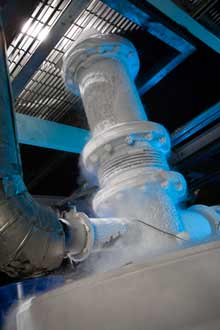Pulverized and Recycled Vulcanized Rubber ON THE GROUND!
Sometimes when you’re really mad and you’re an adult, you just want to throw something on the ground and smash it to smithereens in order to vent your frustration with “the system”. In fact, in the United States each year 300 million tires are thrown on the ground by adults of both genders. Some of these tires are then buried under other trash and discarded objects in landfills, and some of them are sheepishly picked up again and burned for fuel in cement kilns. For a long time, throwing tires on the ground has lacked the pizazz of say, throwing a highball glass full of scotch into a fireplace in a fit of pique (not that I did it).
Image credit http://library.thinkquest.org/
What happens when you throw a rubber object on the ground is that it bounces once or twice, flexes a little, and then settles down quietly in its new location. There are no smithereens, which is a shame given that the real satisfaction of throwing something on the ground comes from producing quality smithereens. Not only is it unfun to throw, used rubber is unfun to recycle because it is “vulcanized–hardened and rendered chemically inert–by the addition of sulfur and other compounds to the material’s long molecular chains. Small chunks of used tires can be partially melted and used as filler in asphalt, but devulcanizing rubber involves expensive chemical and thermal processes” (McKenna). And once it’s vulcanized, rubber attempts to live by reason and logic and gets completely out of touch with its emotions.
Enter Lehigh Technologies of Tucker, GA, a company developing a process of smashing old tires in a manner that gives much more satisfaction. They shatter used tires “into a fine powder using a process that involves freezing old rubber and smashing it to pieces. This starts with tires that have been torn into half-inch chunks using conventional shredding equipment. Lehigh mixes these rubber pieces with liquid nitrogen, cryogenically cooling the rubber to -100°C. The rubber is then fed into a high speed ‘turbomill’ that shatters it into particles no more than 180 microns in size” (McKenna). The cryogenic shatter-fest vastly increases the surface area of the rubber – transforming it from inert filler material to something special with new properties (such as the ability to bond with other materials).
Image credit Technology Review
It should be noted however, that Lehigh rubber is in no way devulcanized, which means that carbon atoms in the rubber are still bound to sulfur atoms. This prevents the atoms from forming covalent bonds with surrounding materials. To address the shortcoming, Lehigh “opened an in-house research center seeking to change the chemical properties of powders it produces…. The company has also developed ways to make recycled rubber bind to surrounding materials via noncovalent, intermolecular bonds” (McKenna).
The rubber powder made from old tires should open up new recycling opportunities, and Lehigh Technologies has opened a commercial facility with capacity to produce 100 million pounds of powder from four million tires per year. They recognize that there could be a billion-dollar market for high-performance recycled rubber (McKenna). But remember, you can’t trust the system!
WU XING:
Rubber is filed under the wood category, but because this is a frozen, pulverized kind of rubber I thought about putting it in the earth category as well. I decided against it, because I’M AN ADULT.
Cited:
McKenna, Phil. “New Life for Old Tires” Technology Review 04/20/10. Accessed 05/11/10. URL.


















Leave a Wordpress Comment: